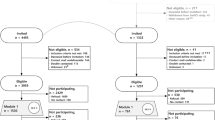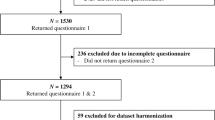Abstract
Study design
Longitudinal community survey.
Objectives
To determine subgroups in social participation of individuals living with spinal cord injury (SCI).
Setting
Community.
Methods
Data were collected in 2012 and 2017 as part of the community survey of the Swiss Spinal Cord Injury cohort. Participation was assessed using the 33-item Utrecht Scale of Evaluation of Rehabilitation-Participation evaluating frequency of, restrictions in and satisfaction with productive, leisure, and social activities. Linear mixed-effects model trees were used to distinguish subgroups in participation associated with sociodemographic and lesion characteristics.
Results
In all, 3079 observations were used for the analysis, of which 1549 originated from Survey 2012, 1530 from Survey 2017, and 761 from both surveys. Participants were mostly male (2012: 71.5%; 2017: 71.2%), aged on average 50 years (2012: 52.3; 2017: 56.5), with an incomplete paraplegia (2012: 37.5%; 2017: 41.8%) of traumatic origin (2012: 84.7%; 2017: 79.3%). There was limited within-person variation in participation over the 5-year period. Participation varied with age, SCI severity, education, financial strain, number of self-reported health conditions (SHCs), and disability pension level. Among modifiable parameters, the number of SHCs and disability pension level emerged as the most frequent partitioning variables, while education was most informative for participation in productive, leisure, and social activities.
Conclusions
Long-term rehabilitation management and clinical practice should target people most prone to decreased participation in major life domains. Our study indicates that the alleviation of SHCs, engagement in further education, or adjusting disability pension level are promising areas to improve participation of persons living with SCI.
Similar content being viewed by others
Log in or create a free account to read this content
Gain free access to this article, as well as selected content from this journal and more on nature.com
or
Data availability
Owing to our commitment to SwiSCI study participants and their privacy, data sets generated during the current study are not made publicly available but can be provided by the SwiSCI Study Center based on reasonable request (contact@swisci.ch)
Notes
The Community Survey: https://swisci.ch/en/research-projects-home/study-design/community-survey.
References
Barclay L, McDonald R, Lentin P. Social and community participation following spinal cord injury: a critical review. Int J Rehabil Res. 2015;38:1–19.
Kennedy P, Lude P, Taylor N. Quality of life, social participation, appraisals and coping post spinal cord injury: a review of four community samples. Spinal Cord. 2006;44:95–105.
van Leeuwen CM, Post MW, Westers P, van der Woude LH, de Groot S, Sluis T, et al. Relationships between activities, participation, personal factors, mental health, and life satisfaction in persons with spinal cord injury. Arch Phys Med Rehabil. 2012;93:82–9.
Hornby-Turner YC, Peel NM, Hubbard RE. Health assets in older age: a systematic review. BMJ Open. 2017;7:e013226.
Weitzenkamp DA, Jones RH, Whiteneck GG, Young DA. Ageing with spinal cord injury: cross-sectional and longitudinal effects. Spinal Cord. 2001;39:301–9.
Savic G, Frankel HL, Jamous MA, Soni BM, Charlifue S. Participation restriction and assistance needs in people with spinal cord injuries of more than 40 year duration. Spinal Cord Ser Cases. 2018;4:28.
Krause JS, Bozard JL. Natural course of life changes after spinal cord injury: a 35-year longitudinal study. Spinal Cord. 2012;50:227–31.
Charlifue S, Gerhart K. Community integration in spinal cord injury of long duration. NeuroRehabilitation. 2004;19:91–101.
Bushnik T. Access to equipment, participation, and quality of life in aging individuals with high tetraplegia (C1-C4). Top Spinal Cord Inj Rehabil. 2002;7:17–27.
Johnston M, Nissim EN, Wood K, Hwang K, Tulsky D. Objective and subjective handicap following spinal cord injury: interrelationships and predictors. J Spinal Cord Med. 2002;25:11–22.
Pershouse KJ, Barker RN, Kendall MB, Buettner PG, Kuipers P, Schuurs SB, et al. Investigating changes in quality of life and function along the lifespan for people with spinal cord injury. Arch Phys Med Rehabil. 2012;93:413–9.
Brinkhof MW, Fekete C, Chamberlain JD, Post MW, Gemperli A, SwiSCI Study Group. Swiss national community survey on functioning after spinal cord injury: protocol, characteristics of participants and determinants of non-response. J Rehabil Med. 2016;48:120–30.
Gross-Hemmi MH, Gemperli A, Fekete C, Brach M, Schwegler U, Stucki G. Methodology and study population of the second Swiss national community survey of functioning after spinal cord injury. Spinal Cord. 2020; https://doi.org/10.1038/s41393-020-00584-3.
Post MW, van der Zee CH, Hennink J, Schafrat CG, Visser-Meily JM, van Berlekom SB. Validity of the utrecht scale for evaluation of rehabilitation-participation. Disabil Rehabil. 2012;34:478–85.
Mader L, Post MW, Ballert CS, Michel G, Stucki G, Brinkhof MW. Metric properties of the utrecht scale for evaluation of rehabilitation-participation (USER-Participation) in persons with spinal cord injury living in Switzerland. J Rehabil Med. 2016;48:165–74.
de Ruijter LS, de Groot S, Adriaansen JJ, Smit CA, Post MWM. Associations between time since onset of injury and participation in Dutch people with long-term spinal cord injury. Spinal Cord. 2018;56:1134–43.
van der Zee CH, Priesterbach AR, van der Dussen L, Kap A, Schepers VP, Visser-Meily JM, et al. Reproducibility of three self-report participation measures: the ICF measure of participation and activities screener, the participation scale, and the utrecht scale for evaluation of rehabilitation-participation. J Rehabil Med. 2010;42:752–7.
van der Zee CH, Post MW, Brinkhof MW, Wagenaar RC. Comparison of the utrecht scale for evaluation of rehabilitation-participation with the ICF measure of participation and activities screener and the WHO Disability Assessment Schedule II in persons with spinal cord injury. Arch Phys Med Rehabil. 2014;95:87–93.
Kalpakjian CZ, Scelza WM, Forchheimer MB, Toussaint LL. Preliminary reliability and validity of a spinal cord injury secondary conditions scale. J Spinal Cord Med. 2007;30:131–9.
Fokkema M, Smits N, Zeileis A, Hothorn T, Kelderman H. Detecting treatment-subgroup interactions in clustered data with generalized linear mixed-effects model trees. Behav Res Methods. 2018;50:2016–34.
Kundu MG, Harezlak J. Regression trees for longitudinal data with baseline covariates. Biostat Epidemiol. 2019;3:1–22.
Zeileis A, Hothorn T, Hornik K. Model-based recursive partitioning. J Comput Graph Stat. 2008;17:492–514.
R Core Team. A language and environment for statistical computing. R Foundation for Statistical Computing, Vienna, Austria. 2020. https://www.R-project.org/.
Konlaan BB, Bygren LO, Johansson SE. Visiting the cinema, concerts, museums or art exhibitions as determinant of survival: a Swedish fourteen-year cohort follow-up. Scand J Public Health. 2000;28:174–8.
Rivers CS, Fallah N, Noonan VK, Whitehurst DG, Schwartz CE, Finkelstein JA, et al. Health conditions: effect on function, health-related quality of life, and life satisfaction after traumatic spinal cord injury. A prospective observational registry cohort study. Arch Phys Med Rehabil. 2018;99:443–51.
Buzzell A, Camargos KC, Chamberlain JD, Eriks-Hoogland I, Hug K, Jordan X et al. Receiving or not receiving treatment for secondary health conditions within the spinal cord injured community: results from a descriptive analysis using survey data. Spinal Cord (submitted).
White GW, Gonda C, Peterson JJ, Drum CE. Secondary analysis of a scoping review of health promotion interventions for persons with disabilities: do health promotion interventions for people with mobility impairments address secondary condition reduction and increased community participation? Disabil Health J. 2011;4:129–39.
van Hees SGM, van den Borne BHP, Menting J, Sattoe JNT. Patterns of social participation among older adults with disabilities and the relationship with well-being: a latent class analysis. Arch Gerontol Geriatr. 2020;86:103933.
Reinhardt JD, Fellinghauer CS, Post MWM. Change in environmental barriers experienced by people living with spinal cord injury in Switzerland over a five-year period: a prospective cohort study. Spinal Cord. 2020; https://doi.org/10.1038/s41393-020-00580-7.
Schwegler U, Fekete C, Finger M, Karcz K, Staubli S, Brinkhof MWG. Labor market participation of individuals with spinal cord injury living in Switzerland: determinants of between-person differences and counterfactual evaluation of their instrumental value for policy intervention outcomes. Spinal Cord (submitted).
Fekete C, Siegrist J, Reinhardt JD, Brinkhof MW. Is financial hardship associated with reduced health in disability? The case of spinal cord injury in Switzerland. PloS ONE . 2014;9:e90130.
Venkatasubramaniam A, Wolfson J, Mitchell N, Barnes T, JaKa M, French S. Decision trees in epidemiological research. Emerg Themes Epidemiol. 2017;14:11.
Acknowledgements
We thank the SwiSCI Steering Committee with its members Xavier Jordan and Fabienne Reynard (Clinique Romande de Réadaptation, Sion); Michael Baumberger and Hans Peter Gmünder (Swiss Paraplegic Center, Nottwil); Armin Curt and Martin Schubert (University Clinic Balgrist, Zürich); Margret Hund-Georgiadis and Kerstin Hug (REHAB Basel, Basel); Laurent Prince (Swiss Paraplegic Association, Nottwil); Heidi Hanselmann (Swiss Paraplegic Foundation, Nottwil); Daniel Joggi (Representative of persons with SCI); Nadja Münzel (Parahelp, Nottwil); Mirjam Brach and Gerold Stucki (Swiss Paraplegic Research, Nottwil); Armin Gemperli (SwiSCI Coordination Group at Swiss Paraplegic Research, Nottwil).
Funding
SwiSCI is hosted and funded by Swiss Paraplegic Research.
Author information
Authors and Affiliations
Contributions
MHGH, MWGB, and CF were responsible for designing and planning of the present study. MHGH was responsible for data analysis, interpretation, and development of the present paper. ASS, US, and MWMP contributed to the study proposal, to interpretation and discussion of results, and approved the final paper. All authors participated in a critical revision of this paper for important intellectual content and ultimately approved of the final version based on this submission.
Corresponding author
Ethics declarations
Conflict of interest
The authors declare that they have no conflict of interest.
Ethical approval
Ethical approval for Survey 2012 was approved by the principal ethics committee on research involving humans of the Canton of Lucerne (KEK Luzern, internal application 11042, approved June 28, 2011) and subsequently endorsed by the additional involved cantonal ethics committees of Cantons Basel-Stadt (EK Basel, internal application 306/11, approved September 6, 2011) and Valais (CCVEM Sion, internal application CCVEM042/11, approved December 6, 2011). Ethical approval for Survey 2017 was granted by the leading ethical institution Ethikkommision Nordwest-und Zentralschweiz (EKNZ, Project-ID: 11042 PB_2016-02608, approved December 2016). We certify that all applicable institutional and governmental regulations concerning the ethical use of human volunteers were followed during the course of this research.
Additional information
Publisher’s note Springer Nature remains neutral with regard to jurisdictional claims in published maps and institutional affiliations.
Supplementary information
Rights and permissions
About this article
Cite this article
Gross-Hemmi, M.H., Fekete, C., Post, M.W.M. et al. Detecting subgroups in social participation among individuals living with spinal cord injury: a longitudinal analysis of community survey data. Spinal Cord 59, 419–428 (2021). https://doi.org/10.1038/s41393-020-00576-3
Received:
Revised:
Accepted:
Published:
Issue date:
DOI: https://doi.org/10.1038/s41393-020-00576-3
This article is cited by
-
Functioning performance trajectory and its associated factors for people with disability—A 4-year national study
BMC Public Health (2025)
-
Bladder and bowel function effects on emotional functioning in youth with spinal cord injury: a serial multiple mediator analysis
Spinal Cord (2023)
-
Self-care in spinal cord injuries inventory (SC-SCII) and self-care self-efficacy scale in spinal cord injuries (SCSES-SCI): development and psychometric properties
Spinal Cord (2021)



